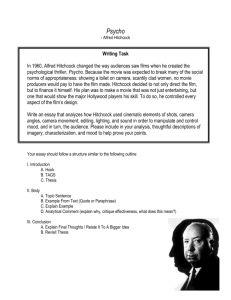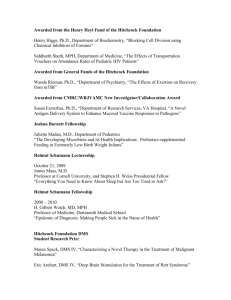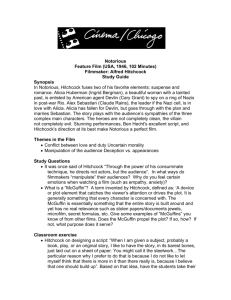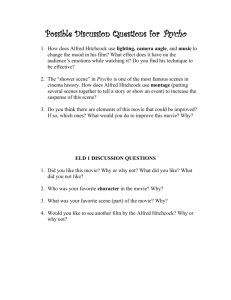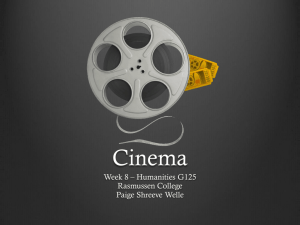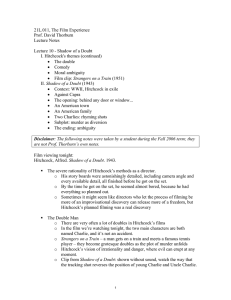21L.011, The Film Experience Prof. David Thorburn Lecture Notes
advertisement
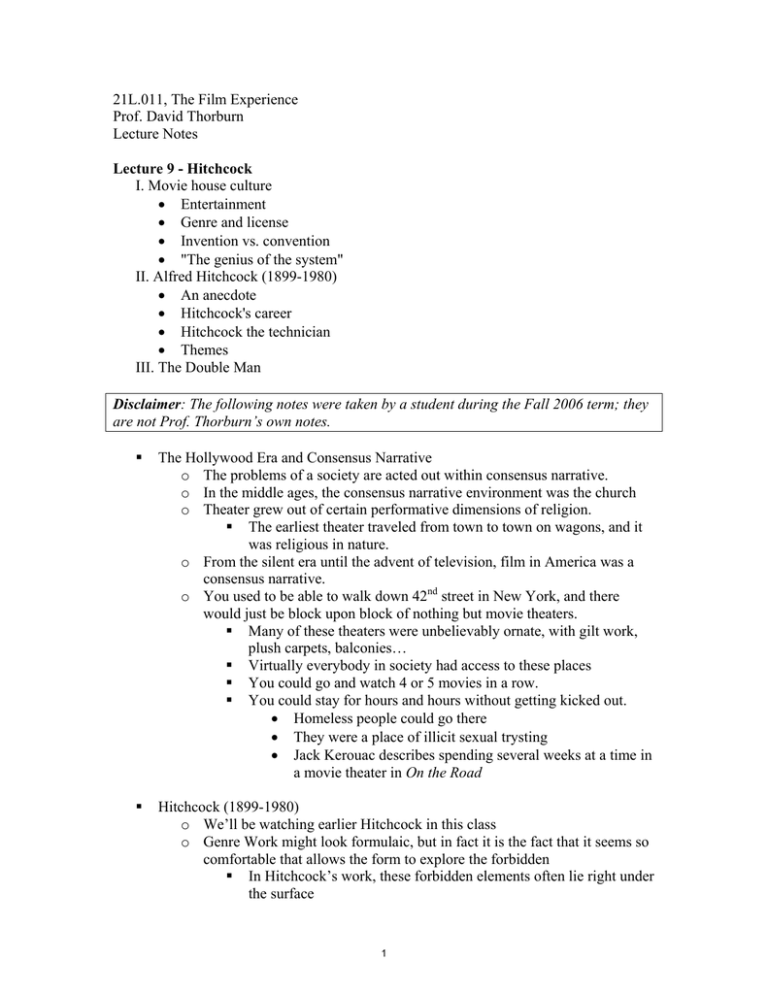
21L.011, The Film Experience Prof. David Thorburn Lecture Notes Lecture 9 - Hitchcock I. Movie house culture Entertainment Genre and license Invention vs. convention "The genius of the system" II. Alfred Hitchcock (1899-1980) An anecdote Hitchcock's career Hitchcock the technician Themes III. The Double Man Disclaimer: The following notes were taken by a student during the Fall 2006 term; they are not Prof. Thorburn’s own notes. The Hollywood Era and Consensus Narrative o The problems of a society are acted out within consensus narrative. o In the middle ages, the consensus narrative environment was the church o Theater grew out of certain performative dimensions of religion. The earliest theater traveled from town to town on wagons, and it was religious in nature. o From the silent era until the advent of television, film in America was a consensus narrative. o You used to be able to walk down 42nd street in New York, and there would just be block upon block of nothing but movie theaters. Many of these theaters were unbelievably ornate, with gilt work, plush carpets, balconies… Virtually everybody in society had access to these places You could go and watch 4 or 5 movies in a row. You could stay for hours and hours without getting kicked out. Homeless people could go there They were a place of illicit sexual trysting Jack Kerouac describes spending several weeks at a time in a movie theater in On the Road Hitchcock (1899-1980) o We’ll be watching earlier Hitchcock in this class o Genre Work might look formulaic, but in fact it is the fact that it seems so comfortable that allows the form to explore the forbidden In Hitchcock’s work, these forbidden elements often lie right under the surface 1 o “High” art vs. “Low” art o Hitchcock is a particularly dramatic example – he’s so unique that we might want to call him a genre unto himself, within the genres of mystery or thriller o An anecdote, which Hitchcock told to many people: his father called him over one day and told him to take a note down the street to the local constable, and the constable read the note and then locked him in a jail cell, and told him “this is what happens to bad boys.” This is representative of the unexpectedness of life – a young boy who has no reason to think he is guilty of anything The eruption of something terrible and unexpected o Hitchcock’s work is full of sudden eruptions of violence and evil – it’s a world of black and white good and evil o He never graduated from college o He worked in film at a variety of levels o Worked for a time in German film, and he was fascinated by German expressionism. o He directed six silent films – he spans both the o The Lodger – 1926. A sort of Jack-the-Ripper story. Innocence accused. o Blackmail, 1929, the first British feature with synchronous sound. About homosexuality – a very shocking subject at that time. o He made The Man Who Knew Too Much, The 39 Steps, and The Lady Vanishes in the 1930s – here he really came into his own, became famous o Rebecca – bestseller, won an academy award, established him as an international figure. o Shadow of a Doubt, 1943 o Rear Window, Verdigo, North by Northwest, Psycho, The Birds – these classics came later, in the 1950s and 60s o His two periods, early and late, are very different o We can think of Hitchcock as a technician and craftsman He was obsessed by every aspect and detail of how movies were made By the time he came on the set, he already had everything planned out He once called actors “cattle” He loved to set himself problems that were difficult to solve, so that these limitations would create a more creative and interesting film. For example, in Rear Window, the entire film takes place in one room o He likes to make brief appearances in all of his films o His themes include: Disorder, Entrapment, Voyeurism, Instability, Evil… o Clip: A famous part of North by Northwest, in which a previously safe environment suddenly becomes a place of menace. This clip is an example of the trauma that he forces his innocent characters to go through 2 Notice the crane shot at the beginning – why does it return at the end? Why is it important? Note how he uses silence Evil erupts from the strangest places in Hitchcock’s universe 3 MIT OpenCourseWare http://ocw.mit.edu 21L.011 The Film Experience Fall 2012 For information about citing these materials or our Terms of Use, visit: http://ocw.mit.edu/terms.
